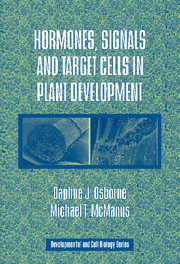Book contents
- Frontmatter
- Contents
- Preface
- 1 Introduction
- 2 Hormones and Signals: Identification and Description of Signalling Molecules
- 3 Cell-to-Cell Signalling: Short and Long Distance
- 4 Population Diversity of Cell Types and Target Identification in Higher Plants
- 5 Flexibility of Cell Types and the Target Cell Status
- 6 Terminally Committed Cell Types and the Target Status
- 7 The Mechanisms of Target Cell Perception and Response to Specific Signals
- 8 Hormone Action and the Relief of Repression
- 9 The Phenomenon of Hormonal Cross-Talk
- References
- Index
2 - Hormones and Signals: Identification and Description of Signalling Molecules
Published online by Cambridge University Press: 06 August 2009
- Frontmatter
- Contents
- Preface
- 1 Introduction
- 2 Hormones and Signals: Identification and Description of Signalling Molecules
- 3 Cell-to-Cell Signalling: Short and Long Distance
- 4 Population Diversity of Cell Types and Target Identification in Higher Plants
- 5 Flexibility of Cell Types and the Target Cell Status
- 6 Terminally Committed Cell Types and the Target Status
- 7 The Mechanisms of Target Cell Perception and Response to Specific Signals
- 8 Hormone Action and the Relief of Repression
- 9 The Phenomenon of Hormonal Cross-Talk
- References
- Index
Summary
As a first step in developing the target cell concept for plants it is important that the major players in the known informational and signal repertoire are set out briefly at the start of the discussions. There are five major players: auxin, gibberellins, cytokinins, ethylene (and its precursor 1-aminocyclopropane-1-carboxylic acid, ACC), and abscisic acid. The first hormone to be discovered and isolated, auxin, is the best understood, the most important and without doubt the most remarkable. As well, the more recent signal molecules to be discovered are described in greater detail for some of them link more closely to molecules in the animal kingdom.
Auxin
Indole-3-acetic acid (IAA) is the most abundant naturally occurring auxin, with indole-3-butyric acid (IBA) and 4-chloroindole-3-acetic acid (4-Cl-IAA) also occurring naturally (Figure 2.1). IAA was discovered in 1928 by Frits Went (Went, 1928) in the search for the chemical substance that was transported from the apex of the oat coleoptile and caused the cells below to elongate. In higher plants, several pathways of synthesis are possible. IAA is an indole derivative, and both in vivo and in vitro evidence indicates routes of synthesis from the aromatic amino acid, tryptophan, although more recent genetic and biochemical experiments have suggested that tryptophan-independent pathways may also operate to yield the final product (Bartel, 1997).
Auxin biosynthesis
Tryptophan was proposed originally as the precursor of IAA due to structural similarities of the two molecules and when a clearly defined conversion was identified in plant-associated microbes.
- Type
- Chapter
- Information
- Publisher: Cambridge University PressPrint publication year: 2005



